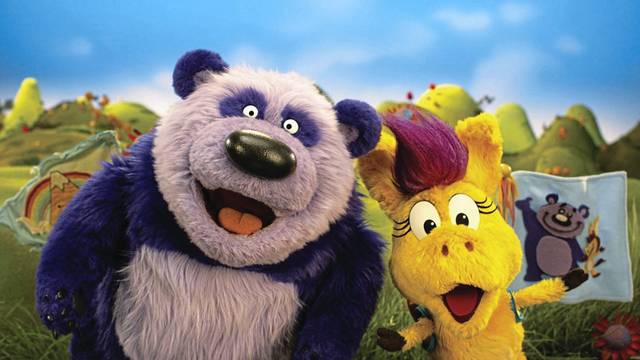https://triblive.com/aande/movies-tv/tv-talk-mister-rogers-neighborhood-spin-off-donkey-hodie-debuts-on-pbs/
TV Talk: ‘Mister Rogers’ Neighborhood’ spin-off ‘Donkey Hodie’ debuts on PBS

Trib Total Media TV writer Rob Owen offers a viewing tip for the coming week.
Even after the director says, “Cut!,” sometimes puppeteers stay in character.
“I said all my lines right!” said Donkey Hodie, as performed and voiced by former Point Park University student Haley Jenkins. And she said it in Donkey’s voice.
Later, as 1989 Peters Township High School grad turned puppeteer Stephanie D’Abruzzo (“Avenue Q,” “Helpsters!”) performed Duck Duck, she demurred on saying “Thank you! Thank you!”
“It’s a little too Little Caesars,” she said in Duck Duck’s voice between takes before cameras rolled again with a single “thank you” uttered.
It was just another day on the set of “Donkey Hodie,” a puppet show spin-off of “Mister Rogers’ Neighborhood” for PBS Kids that debuts at 10 a.m. and 1:30 p.m. Monday on WQED-TV.
In production since November 2019 and continuing through November 2021, “Donkey Hodie” stars the purple-mohawked granddaughter of the original donkey character who appeared in 59 episodes of “Mister Rogers’ Neighborhood.” Donkey Hodie was seen in puppet segments in the Neighborhood of Make Believe, residing in its neighboring land, Someplace Else. (In this series the original Donkey Hodie goes by Grampy Hodie.)
New friends
This series follows the everyday adventures of Donkey and her puppet pals, Purple Panda, Bob Dog and Duck Duck.
In one early episode, Donkey tries to make “flying flapjacks” for Grampy all by herself but learns the value of asking for help. In another story, Donkey and Purple Panda turn a problem — Panda’s lost stuffed pickle — into a game with Donkey enthusing, “That’s a hee-hawesome game!”
Hands-on production
Designed for preschoolers ages 3-5, “Donkey Hodie” is a co-production between Pittsburgh’s Fred Rogers Productions and Chicago-based Spiffy Pictures, the company founded by Adam and David Rudman, who are credited as the creators of “Donkey Hodie,” “inspired by the work of Fred Rogers.” The Rudmans also make the animated “Nature Cat” for PBS Kids and previously made puppet series “Bunnytown” and “Jack’s Big Music Show.” “Donkey Hodie” films in a 10,000-square-foot studio at Chicago PBS station WTTW-TV.
“With this show, we’re a lot more hands-on,” said David Rudman, who performs Bob Dog. (Adam is the “Donkey Hodie” head writer.) “With animated shows, we don’t do the actual animation. This show, we’re physically involved in making and in all aspects of the writing, storyboarding, directing and producing.”
In March during one of two virtual set visits, David Rudman said the production was halfway through its first-season order, having filmed 21 of 40 episodes. Each week, the show films two 11-minute segments that comprise each episode.
Ellen Doherty, the Pittsburgh-based chief creative officer for Fred Rogers Productions and an executive producer who helped develop “Donkey Hodie,” said the series came about after looking through a list of names of characters featured on “Mister Rogers’ Neighborhood.”
“Donkey Hodie was funny and it just made us laugh,” Doherty said, noting Rogers took the name from Cervantes’ “Don Quixote.” “And it gelled into this little donkey with big dreams and that idea of what’s an impossible dream to a preschooler?”
Given the origin of the title, the show’s curriculum around perseverance, resilience and problem-solving fit right in and has only become more relevant during the pandemic.
“It’s core preschool stuff,” Doherty said. “It’s executive functions, self-control and the cognitive function of thinking things through, being able to control your body when you’ve got to wait and not wiggle, which can be really hard.”
Each episode features music, including original songs and adaptations of Fred Rogers’ tunes (“Today is New,” “I Like to Take My Time,” “I’m Proud of You”).
Delayed by covid
Originally announced with a January 2020 premiere, the pandemic was a factor in the show’s premiere getting delayed.
“As far as puppeteering in a pandemic, well, the good thing is nobody sees us, because were below the frame working the characters, so we can wear masks all the time,” David Rudman said. “We social distance as much as we can, but when were shooting, we have to be closer to each other but we never take our masks off.”
Sets are built about 5 feet off the ground to allow puppeteers to stand while performing their characters in front of the camera.
Production designer Justin Vandenberg showed off exterior sets of Donkey’s windmill-shaped house both large (for when characters are standing near it) and small (for perspective when characters are far from the windmill).
“We definitely drew inspiration early on from ‘Mister Rogers’ Neighborhood,’ ” Vandenberg said. “There are subtle hints throughout the entire world.”
Pathways are painted in the same multi-colored pattern as the floor in the WQED-TV studio was for filming scenes in the Neighborhood of Make-Believe on “Mister Rogers’ Neighborhood.”
Inside Donkey’s house, viewers will spot a fish tank and stoplight, nods to the décor on the interior of Rogers’ house on the “Neighborhood.” A swing on Grampy’s porch is meant to call to mind the swing on Mister Rogers’ front porch.
Pittsburgh ties
Doherty said it was a happy accident that so many people with Pittsburgh ties are involved in “Donkey Hodie.”
In addition to veteran puppeteer D’Abruzzo, Donkey is performed and voiced by North Carolina native Jenkins, who attended Point Park University from 2005 to 2006, studying musical theater. She credited one of her Point Park instructors, Mary Rawson, who played Cousin Mary Owl on “Mister Rogers’ Neighborhood,” with helping Jenkins find courage.
“I am naturally a very shy person, and I was especially shy as an 18-year-old in school, terrified of looking silly or not talented,” Jenkins said, noting Rawson’s use of improv games in class taught her about the importance of play versus trying to be funny. “It changed my view of performance. … Once you can let go of the fear of, ‘How will people feel about me?’ it just becomes this fun, ridiculous game.”
Jenkins left Point Park to join the Disney College Program, where she became a puppeteer on “Voyage of the Little Mermaid” at Disney’s Hollywood Studios theme park. In addition to “Donkey Hodie,” Jenkins puppets some “Sesame Street” characters, including foster monster Karli.
Bringing it back to Pittsburgh, Jenkins played a “Mister Rogers’ Neighborhood” puppeteer in the filmed-in-Pittsburgh 2019 Tom Hanks movie “A Beautiful Day in the Neighborhood,” including in a musical dream sequence that got cut from the movie.
Playing Donkey marks Jenkins’ first lead role in an ongoing TV series.
“Donkey’s incredibly enthusiastic and really wears her emotions on her sleeves,” Jenkins said. “I think maybe in the beginning we were all playing it a little safe, and as the show has gone on, it’s gotten quirkier.”
McMurray native D’Abruzzo also writes scripts for some “Donkey Hodie” episodes.
“It was great to have puppeteered some (‘Donkey Hodie’) episodes before I dove in as a writer,” D’Abruzzo said. “I knew who the characters were. I saw what Haley, (puppeteer) Frankie (Cordero) and David (Rudman) were doing with their characters. … I’ve been lucky to have written four scripts so far. It’s fun to do both.”
As for performing in the voice of Duck Duck even after the cameras have stopped filming, D’Abruzzo said play is important in the development of the characters beyond what is written in scripts.
“What we do when the cameras aren’t rolling, that’s how we find things in the character,” she said. “We interact with each other, with the crew. I am a giant ham, and when you work in this kind of television where there is no real live audience reacting in real time, you’re trying to make the crew laugh, and then if you can do that, you know you’re onto something.”
During another take on the show’s Chicago set in February, D’Abruzzo bumped into a piece of the set during filming.
“I made the grass move, I’m sorry,” D’Abruzzo said in her voice before switching into the voice of Duck Duck: “Sorry about that, folks. I was acting very hard.”
Copyright ©2026— Trib Total Media, LLC (TribLIVE.com)
